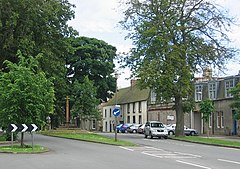Ormiston
| Ormiston | |
|---|---|
 Mercat Cross in Main Street, Ormiston |
|
| Ormiston shown within East Lothian | |
| OS grid reference | NT410691 |
| Civil parish |
|
| Council area | |
| Lieutenancy area | |
| Country | Scotland |
| Sovereign state | United Kingdom |
| Post town | TRANENT |
| Postcode district | EH35 |
| Dialling code | 01875 |
| Police | Scottish |
| Fire | Scottish |
| Ambulance | Scottish |
| EU Parliament | Scotland |
| UK Parliament | |
| Scottish Parliament | |
Ormiston is a village in East Lothian, Scotland, near Tranent, Humbie, Pencaitland and Cranston, located on the north bank of the River Tyne at an elevation of about 276 ft.
The village was the first planned village in Scotland, founded in 1735 by John Cockburn (1685–1758), one of the initiators of the Agricultural Revolution.
The word Ormiston is derived from a half mythical Anglian settler called Ormr, meaning 'serpent' or 'snake'. 'Ormres' family had possession of the land during the 12th and 13th centuries. Ormiston or 'Ormistoun' is not an uncommon surname, and Ormr also survives in some English placenames such as Ormskirk and Ormesby. The latter part of the name, formerly spelt 'toun', is likely to descend from its Northumbrian Old English and later Scots meaning as 'farmstead' or 'farm and outbuildings' rather than the meaning 'town'.
There was an "Ormiston" in Berwickshire, near Linton, where the legend of the Worm of Linton was related to land ownership by Lord Somerville and Lord Lindsay. The Cockburn family may have brought the name from the Berwickshire "Ormiston" to the East Lothian location in the 14th-century.
The village consists mainly of a broad Main Street, with a row of mostly two storey houses along each side. It crosses two bridges, one over the now redundant railway route, and the other a narrow bridge over the river Tyne. Using strict guidelines for its appearance, John Cockburn put housing for artisans and cottage industries (spinning and weaving) around the original mill hamlet. When he did not achieve the expected return on his investment, he sold it to the Earl of Hopetoun in 1747. The linen trade became a failure, and by 1811 the distillery shut down. A brewery and one of Scotland's first bleachfields were also built here as well. Ormiston later became a mining village. The Ormiston Coal Company, whose workings were south of Tranent in East Lothian. The company were one of a number of small concerns working either a single or a few linked, small pits on the East Lothian coalfield. ().
...
Wikipedia

